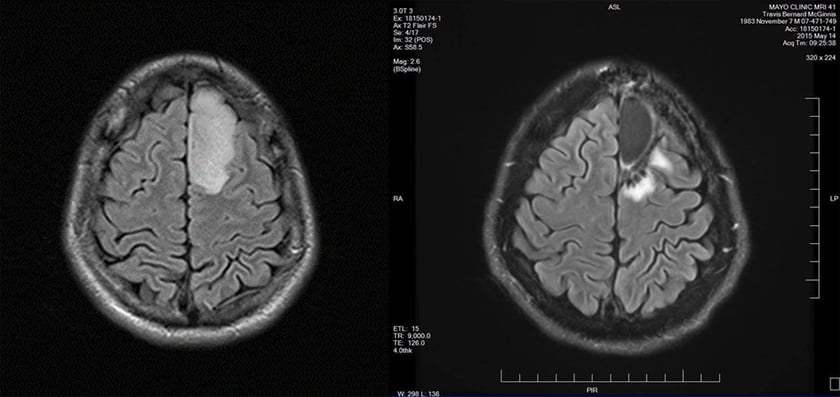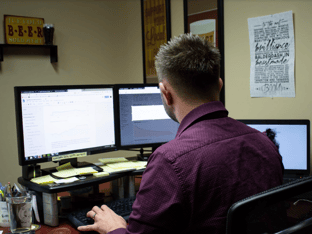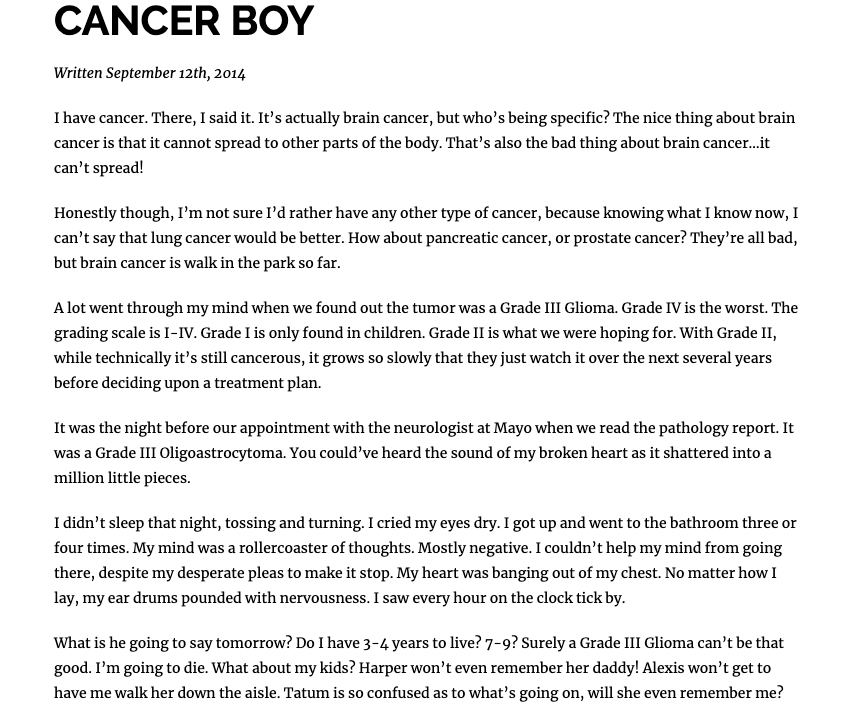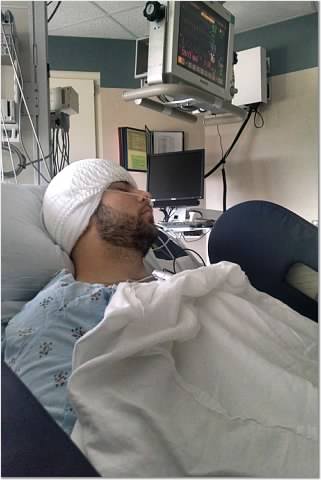The Story of Travis McGinnis of Leighton Interactive
“I can smell the ozone.”
It’s raining and thundering outside the offices of Leighton Interactive, rain pelting against the windows overlooking St. Germain in downtown St. Cloud, MN. After a particularly loud clap of thunder, a bolt of lightning struck the radio tower atop our building. Those words cause all of our heads to look in one direction: at Travis McGinnis, our Technical Marketing & Support Lead.
 “No, I really can. It has a particular smell.” Had anyone else in our agency said those words, we wouldn’t have batted a collective eye, but Travis is different. Five years ago, he had a brain tumor the size of a fist removed from his skull, a cancerous Oligoastrocytoma that was a Grade III Glioma. We sat as a team that day and gathered for a "lunch and learn". We huddled over our warm food, different scents wafting across the conference room. We waited, watching Travis.
“No, I really can. It has a particular smell.” Had anyone else in our agency said those words, we wouldn’t have batted a collective eye, but Travis is different. Five years ago, he had a brain tumor the size of a fist removed from his skull, a cancerous Oligoastrocytoma that was a Grade III Glioma. We sat as a team that day and gathered for a "lunch and learn". We huddled over our warm food, different scents wafting across the conference room. We waited, watching Travis.
He must have sensed our expectations, and our concern. “Guys, it’s fine. I’m fine. That ozone scent is identical to the scent the hockey place uses to clean my girls’ hockey gear. They pump ozone onto hockey gear to clean it.”
One by one, we exhale.
2014
You know the feeling when your hand or foot falls asleep? That tingling feeling is what tipped Travis off that something might not be right. Except it wasn’t an appendage, it was his head. He also was experiencing bizarre thoughts of what people were doing and saying around him, things that weren’t actually happening. There were no headaches, no dizzying pain or loss of vision, just a random tingling feeling here and there. He attributed it to his age (in 2014, he was 30) or stress. He knew his yearly physical was coming up and he planned on mentioning his tingling head to his doctor at the appointment.
One particular Friday night, Travis was unloading DJ gear after a show. He had a part time gig as a wedding and teen dance DJ. It was around midnight when he experienced perhaps the most frightening thing that can happen to anyone: he lost the ability to speak and articulate his thoughts. He chalked it up to a late-night and exhaustion but he was spooked.
Fast-forward to the next month. He’s at his annual physical and mentions his head to his primary doctor who ordered an MRI. “You can never be too cautious when it comes to the brain,” he explains.
It was a Friday night in June. Travis’ wife Kayleigh and their one-month-old daughter, Harper, were with him at the hospital when they determined the cause of the tingling and occasional numbness; a fist-sized tumor on the left side of his brain measuring about 5cm by 7cm.

The fist-sized tumor on the left, and post-surgery hole on the right.
They were hoping for a low-grade malignancy, and a total tumor resection was scheduled. There’s no biopsy step involved when the tumor is attached to the brain; it has to come out. Surgery was set for August 7, 2014 at the Mayo Clinic in Rochester, MN, 48 days away. What would Travis do in those 48 days?
He’d do what he always does. He’d go to work.
This is Your Brain at Work
Not a day goes by that someone at work doesn’t mention Travis’ brain but in the academic and proficiency-sense, not the cancer-sense.
The role he plays at Leighton Interactive and what his role encompasses is not for the faint-of-heart. As our Technical Marketing and Support Lead, he’s tasked with all the mechanics of marketing: the nitty-gritty technical … stuff. This has the effect of making the creatives of our agency (myself included) not only endlessly appreciate his ability, but marvel at how close he came to losing it. His brain is arguably his best asset, at least at work. As his co-workers and team, we’re biased...and highly dependent.
Left-Brain vs. Right-Brain
There’s also never a day, and usually, never even an hour one of us doesn’t say, I can’t figure it out. Ask Travis. Or, Hmmm. That sounds like a question for Travis. Or simply, WHERE IS TRAVIS? Our reliance on his technical acumen and marketing knowledge comforts us and keeps us competitive. It’s the best of both worlds.

Travis is a natural left-brain thinker. Left-brainers are quantitative and analytical. They are ruled by logic and pay close attention to the world around them, ensuring everything makes sense. When it comes to the weather, for example, they’ll understand the forecast calls for a 20 percent chance of rain, but they’ll note cumulonimbus clouds present in the sky mean thunder is also very likely.
Many of us, myself included, are right-brainers who are intuitive and creative free thinkers. We experience the world as qualitative, big-picture types. We’re both descriptive and subjective. We know it’s going to rain because the skies are an ominous, swirling gray, and those clouds are big as hell.
And in those 48 days between knowing he had brain cancer and his surgery date, Travis never wavered in his role or what was expected of him at work. He didn’t dwell on what was at risk, his life, his role as a father and husband, and his career. His precious left-brain tendency was also home to the exact place where a giant tumor was jeopardizing everything. He simply went back to work, head down, tumor intact and did what he’s always done. Fear was real, but it didn’t creep into his workdays. He was grateful for the distraction Leighton Interactive provided him. That summer, everything hung in precious balance and he trusted he’d be back at his desk after surgery.
He just didn’t know what that would look like yet.
In His Own Words
Maybe because he’s a marketer or a communicator by trade, or maybe he was prompted by someone medically. Travis kept a journal before, during, and after his brain cancer diagnosis. This practice would prove beneficial as he wrote and published his first book, The Tale of the Fist-Sized Hole.
This is a page is from his journal.

The Big Stage
Travis is preparing for one of the biggest highlights of his career: speaking at the Inbound Conference in Boston the first week of September. Inbound is a massive conference celebrating a “community of people who are passionate about marketing, selling, and delighting customers in an inbound way. The annual event and year-round media platform inspire and educate hundreds of thousands of people so that they and their businesses can grow better.” Each year the event draws 25,000-ish people at one of the nation’s largest event centers in the historic Boston Harbor. Making it onto the speaking track is highly competitive and plenty cutthroat; the event features around 250 speakers across a three-day agenda.

Pitching your speaking topic is part expertise and part hope, attributes Travis knows plenty about. He actually applied to speak in 2018, but was summarily rejected. In 2019, he applied again, this time with a different approach and a topic he thought had a solid chance of being accepted.
His topic is What’s In a CTA? Tips, Tricks, and Statistics — click the link to see some BTS (behind the scenes) promotion of his presentation — and he's listed alongside some definite heavy hitters speaking at Inbound in 2019. Just how heavy? Some of these names might sound familiar:
… to name a few. We hope Travis returns to us without too big of a head. Speaking of, let’s pick up the whole brain cancer story post-surgery.
Lights, Beeping, Action
August 7, 2014 was the day of Travis’ brain surgery to remove his fist-sized tumor. He underwent a six-hour surgery with one of the nation’s top brain surgeons, Dr. Fredric Meyer, and staff at the Mayo Clinic in Rochester, MN. He doesn’t recall a lot of details of the event. He remembers the gurney and necessary pre-op activities. He remembers being comforted by the fact that one of the staff so closely resembled his uncle Greg which was soothing. He remembers hugging and kissing his wife goodbye, the pain in his arm from the I.V., and some lights, some beeping. That’s it.
Brain Function
Those tiny details are just that, so tiny and minuscule in the grand scheme of things. Imagine undergoing brain surgery at age 30, being told the risks as medically mandated prior to any invasive procedure and hoping the small percentages of risk stay small. Travis remembers being told there was a chance he wouldn’t regain his ability to speak.

Because his oligoastrocytoma tumor presented on his frontal left cortex, the part of his brain that was impacted the most by the mass was the part that controlled movement, hand-eye coordination, speech, and cognition. Once the tumor was removed, the brain needed to realize it could restore normal function to Travis’ everyday life. That, as you can imagine, would take some time. It might take forever.
When Travis started the slow journey back to consciousness in recovery, he remembers wanting to speak but being unable to make the tiniest of sounds. Nurses were speaking to him. He nodded when they asked if he wanted to see his wife.
“Hi, baby.” He remembers hearing Kayleigh’s voice at his bedside. He smiled and slipped back into the dark unconsciousness. He spent three days in the ICU and recovery before being discharged to the hotel connected to the Mayo.
Three days. That’s just 72 hours from having his skull opened, brain manhandled, and a fat cancerous tumor removed from his brain. Now Travis and others (like all of us at Leighton Interactive in particular) are careful to truly appreciate the it’s not brain surgery idiom because, in fact, most of what we all deal with on a daily basis is nowhere near what Dr. Meyer does on a daily basis.
Noted.
New Brain, Who Dis
It’s 183 miles from Travis’s home to the Mayo Clinic in Rochester. His post-op cancer treatment included six weeks of radiation five times a week onsite and six cycles of chemotherapy he was able to undergo at CentraCare in St. Cloud. In addition to infant daughter Harper, Travis and Kayleigh have two other daughters, Tatum who was four at the time, and Alexis who was 10. Family was indispensable as they helped keep the home fires burning while Travis worked his way through treatment. He worked his way through healing his brain which meant relearning how to tackle ordinary tasks, including changing Harper’s diapers, using the Keurig, and how to complete multi-stepped processes. It was frustrating, humbling, and worrisome for him. He remembers having an excruciating sensitivity to light and noise — like the sweet squawks of his baby.
Travis focused on his path, his immediate steps one day at a time. And he hoped. He hoped with all he had.
He returned to work after radiation and tolerated the first two cycles of chemo fine, then it started to take its toll. A job he had been doing and loving for over half a decade was foggy, challenging, frustrating, and at times, foreign. He remembers in March 2015 Leighton Interactive president Dan Soldner showing him an article on “chemo brain” and how cancer survivors often experience significant symptoms of chemotherapy treatment and its effects on the human body. Chemo is grueling, and Travis not only had chemo brain, but he also had brain cancer. That’s a one-two punch. He was fighting both mentally and physically.
As a team, the decision was made to have Travis step back from work and focus on healing and adapting to life post-tumor. At first, he admits he fought it, all he had focused on for 10 months was returning to normal, and his career. Except, he wasn’t normal. In retrospect, Travis says it was the right decision even though it was hard. By the end of 2015, he was back full-time and adjusting and adapting to changes the agency had undergone in his absence like new team members, new clients, new workload, and new processes.
The Five-Year Outlook
How much time?
That’s usually the first question people receiving a cancer diagnosis ask. Travis was no different and his thorough analytical self really needed to know what he was dealing with. When it comes to brain tumors, much of the prognosis is in the genetic makeup of the tumor. The presence (or lack thereof) of particular mutations and gene markers indicates how certain types of cancer will respond to treatment. Long story short, his particular tumor was the best of five possible types of tumors.
The Mayo Clinic is running a study on cancer survival rates based on those five variations. They started it 10 years ago and everyone with Travis’ mutation was still around at the time of his prognosis. “You're going to be here for a long time.” That’s what his neurologist told him.
So, in right-brain layman’s terms there isn’t enough data to sufficiently give a true scientific, statistical answer on prognosis. Travis’ neurologist’s wife had the exact same tumor (how’s that for too damn close to home) 24 years ago and is still living and at the time of Travis’ surgery, was living well.
For someone like Travis who needs the data and the absolute origin of everything probable all the time, this probably grates at him a little. I asked him to summarize his life now, five years later.
“I didn’t have a biggest fear before and now I live a life where I know anything can change in an instant. I’ve lived through a nightmare. I try to just live my life thinking and doing things as I’ve always done them. I’d say I’m 99 percent the person I was before cancer. It’s that one percent difference that few people are able to pick up on. My wife notices it, of course! But mostly, I’m just really happy to be here, to still be at Leighton Interactive, to be alive, and trying to see the best in everything.”
Speaking at Inbound 2019
Catch Travis’ Inbound presentation What's In a CTA? Tips, Tricks, & Statistics on Wednesday, September 4th at 1:15 EST in 210 AB West.
This story was also featured on KNSI Radio. Hear the interview here.
